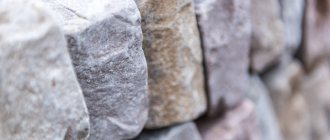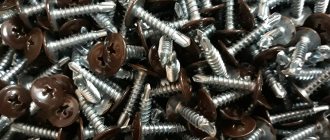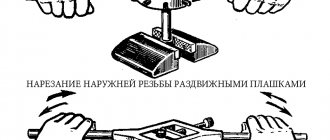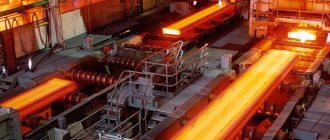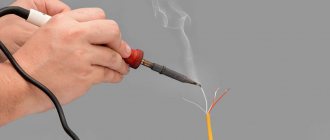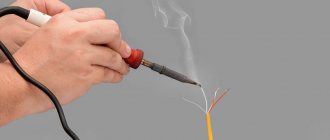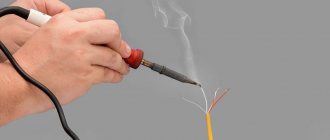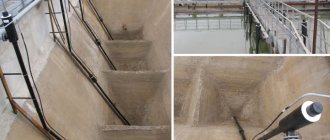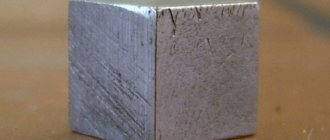Tumbled stone is produced using a unique technology. As a result, the material acquires improved quality characteristics. Polishing and grinding ensure a smooth surface. In addition, using tumbling you can obtain a product of the required shape (both standard and non-standard). All procedures are performed using tumbling equipment.
Metal tumbling: types, fillers, technology – Turner
Good day, dear Kulibins.
___Three years ago I came across this post (links are prohibited)???? It’s a shame, there’s a beautiful picture there. The picture really stuck with me. But at that time I did not have a decent car on which I could use such beauty or technical capabilities. And polishing by hand didn’t really inspire me.
____Time passed... I slowly became interested in polishing. And by chance I came across a description of mechanical polishing using stones/tumbling bodies/chips on the Internet.___This technology interested me very much.
And at the general council a decision was made! “TATTING” to be!___Those who read my blog with my old Rydvan probably remember how last summer I tried to put my alloy wheels in order (read the community rules)???? the link is not allowed, so instead of it???? “A lot of time was spent, but in the end there was little result.”
___And this spring it was decided to do the tumbling myself. They ask for too much money for a finished tumbling machine (and judging by the design, it will fall apart on the first disk).
- ___I went and bought a pipe + a plate, the rest was found in the repair area and after two months of welding work the process was completed.
- ___You can see how tumbling works in the first video you come across from the Internet.
___Over the course of a year, I collected information on the design of the installation itself. Unfortunately, I couldn't find any drawings. So I downloaded a few photos. And already focusing on them, he began to build a “ROCKET”????.
Full size
We assembled the tumbling using available materials. They sculpted what they found in the workshop.
Full size
They didn't chase beauty.
Full size
We installed two platform vibrators. Securing them at an angle of 45 degrees.
Full size
A frequency generator was also purchased to set the vibration frequency.
Full size
To attach the disk, a pipe was used, having previously cut a thread on it.
Full size
The body was made from a water pipe. How do you like its thickness?
Full size
Doesn't it seem like it can't be broken? But we did it. The seams were cut with a grinder and boiled. It's holding up so far, without the duct tape everything would probably have fallen apart.
Full size
The next surprise awaited us from vibration motors. This is outright trash. Bought new. They were assembled, stupidly, on Chinese bearings and without lubrication.
Full size
They learned that they had no lubrication when one motor burned out. We bought another one. We disassembled all the motors, replaced the bearings with normal ones, and lubricated them. While they are working.
Full size
Now about the couch experts. They brought these discs. Killed by industrial sandblasting. The surface of the disc was 60-grit sandpaper. It was possible to sharpen knives.
Full size
We bought shebenka (gravel) and struggled with the discs for a very, very long time.
Full size
After much torment, this is the result.
Full size
This is the maximum that can be obtained from tumbling in sand, shaben, gravel and other materials from a hardware store. There was plenty of time, we tried everything.
Full size
Well, after the gravel, tumbling bodies (chips) of three different fractions were used. Rough grinding. Preliminary and final sanding. At all stages of vibro-polishing, special chemicals are used. Without it, just like without chips, beauty cannot be achieved.
And the result was masterpieces like these.
Tumbling filler otec
Metal tumbling is one of the methods of processing metal parts and workpieces, which involves cleaning the surface from corrosion, scratches, dirt and burrs. The end result of tumbling is similar to the effect of polishing. It is performed on special equipment by processing workpieces with an abrasive, which uses various bulk substances.
Tumbling of metal products
Metal tumbling is one of the methods of processing metal parts and workpieces, which involves cleaning the surface from corrosion, scratches, dirt and burrs. The end result of tumbling is similar to the effect of polishing. It is performed on special equipment by processing workpieces with an abrasive, which uses various bulk substances.
Technology and Application
The tumbling technology is quite simple. The abrasive material, called chips, is loaded into the equipment container along with the workpiece being processed. In some cases, water and compound are added to improve the quality of processing.
A compound is a chemical composition consisting of inhibitors, coagulants and stearin. These chemicals help create a bright, clean surface without darkening.
It also creates a foam that protects delicate materials such as plastic, porcelain and ceramic.
The compound is used everywhere as it helps keep parts clean, which is especially important for maintaining the high quality of the manufactured product.
It is selected individually, depending on the type of material and the final processing goals. It is produced in powder and liquid form. Liquid compound is preferable, as it is more versatile and easier to use.
Powdered is used in exceptional cases when special characteristics are required.
The use of various equipment and chemical compositions allows us to process a wide range of materials. The most common equipment is a circular vibrator. It processes any grade of stainless steel, metal parts made of non-ferrous alloys, plastic, wood products and minerals.
This material processing technology is widely used in various industries. With its help, parts of cars and other equipment, watches, construction tools, hardware, bolts and other fasteners, cutlery, parts of plumbing equipment and many other household items are processed.
The abrasive material is called tumbling bodies. It is used in various shapes, structures and materials. The shape of the tumbling bodies directly depends on the geometric parameters of the workpiece. The abrasive must process all the contours of the workpiece and reach even the smallest depressions and holes.
If hard grinding is required, the abrasive particles have hard edges. The roughness and performance of grinding depends on the size and weight of the chips. Soft round particles have been developed for polishing. It is important that the size of the parts being processed differs significantly from the size of the abrasive so that they can be easily separated. Iron parts can be separated using magnets.
During the process, tumbling bodies of various shapes and sizes can be mixed, and there is also a special additive. It is most often used when processing flat sheets of material that can stick together. The complement represents small balls.
Tumbling technology consists of the following processes:
It is performed in vibration or drum equipment and consists of primary grinding, removal of oxidation and rust, large scratches and burrs.
Most often performed in rotary or centrifugal drum equipment. It is at this stage that you should add the compound. The treatment involves rounding edges, small scratches and burrs, oxidative films, grinding and polishing.
Types of tumbling
Depending on the purposes, several types of tumbling have been developed. Today the following types are distinguished:
The essence of rotary tumbling is the interaction of the metal being processed and the abrasive inside a rotating drum. The quality of material processing using this method is quite high, but the speed and efficiency are quite low.
Therefore, the most common is the vibration method. Vibration of the abrasive occurs due to the vibration drive on which the working container is installed. Surface treatment occurs faster and with better quality. The peculiarities of the method make it possible to process workpieces of any size and shape.
Also, depending on the type of filler, tumbling is divided into:
The dry method involves the use of conventional abrasive filler. The wet method is based on adding water, usually mixed with a coagulant, to the working container. This method is more effective and allows for better cleaning and polishing of the surface. The wet method is indispensable in cases where the workpiece needs to be prepared for the application of enamel or galvanic coating.
There is also a classification based on the type of equipment used:
- drum tumbling;
- planetary tumbling;
- centrifugal tumbling.
Tumbling equipment
Various types of equipment are used in production; each model has certain advantages and disadvantages. Therefore, before choosing a model, it is worth studying its features and characteristics in detail.
Among the most common models for the head of parts are:
This is the simplest type of equipment, which is a cylindrical drum, less often multifaceted. An electric motor is installed at the base of the drum, causing it to rotate. The drum can be positioned vertically, horizontally or at an angle. It is better when it is possible to change the working angle.
To operate, the required amount of abrasive and workpieces is loaded into the drum. Processing of materials occurs due to the constant movement of workpieces in an abrasive environment during the rotation of the container.
The main advantage of this model is its simplicity and low cost. You can make the drum yourself at home. It is great for household plots and small businesses.
But, given a number of shortcomings, such drums are gradually being phased out and replaced by more advanced models.
The main disadvantages include:
- low speed of work, which negatively affects the efficiency and cost of work;
- there is no separation system, which complicates the process of separating products and finishing bodies;
- most models provide only dry processing; it is almost impossible to implement wet processing in practice;
- In drums, only durable products of simple geometric shape can be processed; processing of thin-walled products from fragile materials or objects of complex shape is ineffective;
- such models do not provide for the possibility of visual control of the processing process while the machine is operating; you need to constantly stop the drum and look for the workpiece in the mixture;
- such equipment does not allow achieving uniform surface treatment, therefore it is more suitable for grinding than polishing;
- the drum creates a lot of noise during operation, sometimes strong vibration, so it cannot be used near residential premises, or the workshop needs to be equipped with additional noise insulation.
Due to a large number of shortcomings, drum equipment today is used only in extreme cases when simple surface treatment is required without achieving high quality, or when the treatment is one-time in nature. For such purposes, sometimes a concrete mixer is used, I slightly re-equip it. A drum like this is perfect for removing casting marks.
- Vibration equipment.
It is this type that replaced the drums and is the most popular today. It is based on a working container of various shapes, which can be in the form of a drum, cube, pipe, bath or other shape. A vibration drive is attached to the container. The tumbling bodies and the processed material are loaded into the container. This model allows the use of water and compound.
The vibration drive is driven by an electric motor, transmitting vibrations to the loaded mixture.
The vibration of the abrasive seems small and almost unnoticeable, but such movement allows for high-quality cleaning of the surface due to the rapid and frequent movement of the components relative to each other.
The chips apply micro-impacts to the workpiece, which allows you to clean the surface even in the deepest and most difficult areas.
Vibration equipment is constantly being improved, which can significantly increase its efficiency and productivity. Some models include the installation of a mixer, which additionally rotates the working mixture. Today it is easy to choose a model of any size and power. It has practically no disadvantages, and among the advantages are the following:
- versatility, due to the ability to process workpieces of various sizes and shapes, as well as thin-walled objects and fragile raw materials, you just need to replace the finishing bodies, as well as adjust the power and vibration parameters;
- high productivity, which is achieved due to large working tanks made of powerful electric motors; most models also allow simultaneous processing of workpieces of various types with similar physical parameters;
- high speed, significantly exceeding the speed of drum models;
- allows you to process products and soft materials;
- During the work, you can visually control the result; often you can even remove the workpieces without turning off the equipment.
A simple but quite effective type that is becoming increasingly popular. It is based on a cylindrical container, which is fixedly fixed to the frame. At the base of the container there is a rotating shaft with blades. The working mixture is simply poured into the drum from above.
The shaft is then driven by an electric motor, creating centrifugal motion inside the container. To ensure that the mixture moves evenly around the drum and does not get caught on the edges, the walls of the container are specially profiled. This creates a planetary trajectory for the mixture.
Among the disadvantages of rotary equipment are the ability to process only small, light objects, rapid wear of the walls and bottom of the drum, especially at the point where the container and shaft are attached.
The main advantages are:
- the highest productivity among analogues;
- allows you to simultaneously load a large volume of workpieces;
- by changing the shaft rotation speed, you can control the degree of surface roughness of the part with high accuracy;
- the highest quality of processed surface over the entire area of the workpiece;
- Equipment manufacturers often provide the ability to easily add and drain reagents used in the tumbling process.
- Spindle equipment.
A modern type of equipment that is used in rare cases due to its high complexity. At the same time, it shows the highest quality processing result. Therefore, in some cases, spindle equipment becomes indispensable in production.
Unlike other models, the workpieces are not in the free space of the abrasive mixture; they are attached to a spindle, which is rotated.
The rotating spindle is slowly lowered into the working container with the abrasive mixture. Thanks to the high spindle speed, the abrasive quickly cleans and polishes the surface of the part.
The spindle constantly moves in the mixture so that the abrasive particles replace each other.
The only drawback of this processing is the inability to work with a large number of parts, which is limited by the number of fasteners on the spindle. Most often, such equipment can be found in high-precision mechanical engineering, where special requirements are placed on the surface of parts.
Tumbling fillers
The type of filler directly determines the degree of final processing, be it polishing or grinding the material. The filler for tumbling is selected in accordance with certain requirements. First of all, you need to pay attention to the following factors:
Depending on the type of part used, the abrasive is suitable for finishing ceramic, wood, porcelain, plastic, sand, glass or even nut shells.
- Size of material for tumbling. The size must be selected in such a way that the balls can penetrate small holes, recesses and other hard-to-reach places in the part without getting stuck in them.
- Selection of the shape of the abrasive body. The degree and quality of processing depends on the shape of the body. Depending on the goals, a prism shape can be selected, which allows you to qualitatively get rid of burrs, rounding edges and primary grinding, a cone - for polishing and smoothing smooth surfaces, and a ball - for processing products of complex shapes.
- Select an abrasive based on the required abrasive properties. The degree of processing can vary, from primary grinding to remove large cracks and burrs, to polishing to give a smooth, shiny surface. For example, ceramic tumbling fillers are excellent for rough finishing and large layer removal.
Today, the market offers a huge range of abrasive materials, both domestic and imported.
It is worth noting that the quality of the filler practically does not vary depending on the manufacturer. Therefore, you don’t have to overpay when purchasing filler.
You can only take the manufacturer into account when choosing plastic, since the performance characteristics and service life depend on the quality of the raw materials.
If you plan to use tumbling equipment for home purposes and processing simple metal parts, it is not necessary to purchase factory filler.
Depending on the purposes of processing, improvised materials such as pebbles, finely broken glass or the remains of broken ceramic dishes can be used.
For small equipment, 10 liters of such filler will be enough, which can be used repeatedly.
With proper operation of tumbling equipment and selection of appropriate filler, high-quality processing of workpieces can be achieved. The efficiency of tumbling significantly exceeds the efficiency of manual processing.
, please select a piece of text and press Ctrl+Enter.
Stone tumbling at home
It is almost impossible to grind stones at home and without special equipment. For a single tumbling, you can use some available tools, but the quality of the work cannot be compared with specimens processed using professional equipment.
Tumbling stone using a concrete mixer
To clean stones from dirt and rough grinding at home, you can use a concrete mixer. To do this, the samples to be processed are placed in a concrete mixer, an abrasive filler or detergent is added to it and turned on at a certain speed. It is advisable to pre-build a cover to cover the drum window.
In this way you can tumble medium and large stones. Small samples will be difficult to separate from the abrasive media and are more likely to be damaged.
Machine for tumbling stone at home
If you regularly need to tumble stones at home, you can build a special machine. To do this, you will need a small cylindrical container with a lid, an electric motor (you can take it from a fan or an old washing machine) and a small shaft that will drive a homemade drum. You can also use the shaft of an emery machine with adjustable speed, on which an abrasive wheel is mounted, as an electric drive.
A small amount of stones and abrasive material is placed in a container that is fixed to the machine. After turning on the homemade installation, the stones are ground in with an abrasive filler.
Stone tumbling by hand
Stones with a high level of fragility and softness can be processed manually at home. To do this, you will need a container of water, a metal plate measuring 20x10 cm and fine-grained sandpaper.
Sandpaper is wrapped around a metal plate and then dipped in water. Take a stone in your hands and alternately grind all its edges on sandpaper until they acquire a rounded shape. Periodically, sandpaper must be moistened with water.
This method cannot process a large number of stones, and the quality leaves much to be desired.
What does stone tumbling mean?
Tumbling of minerals is done mechanically, using special equipment for tumbling stones. The drum of the tumbling machine contains abrasive filler and stones that are to be processed. During the process of mixing the contents of the drum at high speed, friction of the processed stones against the abrasive filler occurs, as a result of which the surface of the stone is ground and cleaned of dirt.
Various materials can be used as an abrasive filler:
- Chips made from natural stones with appropriate characteristics of hardness and strength. They usually differ in configuration in the form of a cone, cube or cylinder.
- Abrasive powder.
- Metal balls and needles of various sizes.
- Caustic compounds (soda ash, slaked lime), which help to quickly clean stones from dirt and polish them.
The inside of the drum, in which the tumbling stones are placed, is lined with rubber with a smooth or textured surface. In one container you can process several types of stones that are similar in viscosity and strength. The process of tumbling some types of minerals can sometimes take up to several days.
Tumbling: features of processing metal products
As a rule, a frequency of 10-50 rpm is used for tumbling in bells, and 20-60 rpm in drums. The drums in which tumbling is carried out have a hexagonal or octagonal shape. Also, such equipment is characterized by the presence of a cover. Sheet steel is used for manufacturing. Increasing the quality of mixing is accompanied by the presence of longitudinal corners inside. This is also achieved by rotating around an inclined axis. Equipment made of steel is lined inside with the following materials:
- plastics;
- rubber;
- tree.
The bell in which tumbling is performed is made of sheet steel 3 mm thick. This equipment uses the following materials to remove defects from the surface of metal products:
- emery;
- quartz sand;
- marble and porcelain battle;
- ceramic prisms.
Tumbling of parts
+7
Leave a request, we will calculate everything and contact you!
The tumbling method is selected depending on the volume and size of defects, thickness, shape and size of parts and other surface treatment conditions. Tumbling allows you to clean the surface of metal products, remove using an abrasive method any burrs, traces of corrosion, scale, scratches and other unwanted defects formed after production or during long-term operation. If necessary, long-term polishing can achieve a mirror finish.
Cleaning, processing, grinding, polishing - all these results can be obtained after tumbling the products in a special drum, using abrasive materials (dry and wet). At TorgKoms-Group production, different types of final cleaning are available: drum, vibration, large and fine, rotary, etc.
Tumbling is available for products of different shapes - square, spherical, rectangular, trapezoidal, complex geometry.
- Ceramic
- Plastic
- Organic
To improve the quality of processing, a common method is in which thermoplastic polymer resin (compound) and water are added to the drum.
Technology and abrasives are selected primarily for compatibility with the product material: if it is necessary to maintain maximum identicalness to the original dimensions. Despite all its advantages, tumbling has one significant drawback - the larger the abrasive, the more intense the impact on the part. This parameter is especially important when working with aluminum and other soft materials.
Available for processing - ferrous metal, various types of steel, including stainless and structural, titanium, copper, aluminum and their alloys, types of non-ferrous alloys.
If the requirements for surface quality are not so high or the products initially do not require additional abrasive cleaning, we suggest you consider others for processing rolled metal products:
GALVANIC GALVANIZATION PAINTING
Each type of work contributes to the creation of a reliable protective coating, allowing the parts to also have an aesthetic appearance.
Tell our specialists about the project data, suitable technology and problem solving options will be presented to you as soon as possible. You will receive the finished products in , both upon delivery within Russia and upon pick-up from our warehouse in Moscow.
Have questions? Ask our manager and get the best price!
Tumbling fillers
The type of filler directly determines the degree of final processing, be it polishing or grinding the material. The filler for tumbling is selected in accordance with certain requirements. First of all, you need to pay attention to the following factors:
- Material type.
Depending on the type of part used, the abrasive is suitable for finishing ceramic, wood, porcelain, plastic, sand, glass or even nut shells.
- Size of material for tumbling. The size must be selected in such a way that the balls can penetrate small holes, recesses and other hard-to-reach places in the part without getting stuck in them.
- Selection of the shape of the abrasive body. The degree and quality of processing depends on the shape of the body. Depending on the goals, a prism shape can be selected, which allows you to qualitatively get rid of burrs, rounding edges and primary grinding, a cone - for polishing and smoothing smooth surfaces, and a ball - for processing products of complex shapes.
- Select an abrasive based on the required abrasive properties. The degree of processing can vary, from primary grinding to remove large cracks and burrs, to polishing to give a smooth, shiny surface. For example, ceramic tumbling fillers are excellent for rough finishing and large layer removal.
Today, the market offers a huge range of abrasive materials, both domestic and imported. It is worth noting that the quality of the filler practically does not vary depending on the manufacturer. Therefore, you don’t have to overpay when purchasing filler. You can only take the manufacturer into account when choosing plastic, since the performance characteristics and service life depend on the quality of the raw materials.
If you plan to use tumbling equipment for home purposes and processing simple metal parts, it is not necessary to purchase factory filler. Depending on the purposes of processing, improvised materials such as pebbles, finely broken glass or the remains of broken ceramic dishes can be used. For small equipment, 10 liters of such filler will be enough, which can be used repeatedly.
With proper operation of tumbling equipment and selection of appropriate filler, high-quality processing of workpieces can be achieved. The efficiency of tumbling significantly exceeds the efficiency of manual processing.
The essence of tumbling technology, equipment and materials
Tumbling is the processing of workpieces with bulk or liquid abrasive materials in special containers that are subject to rotation or vibration. We will tell you about the technology, the materials and machines used, and the types of abrasive fillers.
During the manufacturing process of various metal products or parts, defects such as burrs, scale, remnants of casting particles, dirt, or areas of corrosion may form on their surface. All this must be removed from the surface. For these purposes, the tumbling method can be used. What it is? The technological process of processing metal by exposing it to bulk abrasive material, which, together with the parts, is placed inside special equipment and subjected to rotation or vibration.
After tumbling treatment, metal parts acquire a marketable appearance and in some cases may receive additional positive qualities. Abrasive is nothing more than particles of corundum, emery, sand or other materials. Bulk mixtures are used for dry tumbling of steel, while special solutions are used for wet tumbling. The tumbling method is sometimes used to polish products.
Purpose of metal tumbling
As mentioned above, metal tumbling allows you to remove the following defects from the surface of products:
- sharp edges when stamping sheet metal products;
- burrs formed during cutting of workpieces or turning;
- scale after welding or metal cutting;
- remnants of flash from parts made by casting.
In addition, tumbling effectively polishes products to a mirror-like surface. Parts that have been subjected to tumbling can then be subject to galvanic treatment or painting with powder mixtures.
What metals can be tumbled:
- special purpose alloys;
- black metal;
- structural steel;
- AISI stainless alloys;
- titanium materials;
- aluminum and its alloys;
- copper and copper-based alloys;
- silver products.
Tumbling equipment
To perform tumbling operations using the vibration method, special chambers are used, equipped with mechanisms that create vibration (eccentrics). They force the camera to oscillate at a certain frequency from 50 to 15 Hz in different directions, while inside the working space a peculiar movement of workpieces and abrasive material is observed. Vibrating chambers are suitable for tumbling large parts that are pre-fixed inside.
Consumables
- prismatic ceramic particles;
- fine scrap of porcelain and marble;
- steel shot;
- abrasive bodies made of plastic;
- zirconium oxide;
- emery and corundum.
Process description
The tumbling technology is not difficult to understand: it is based on the same effect of abrasive on the surface layer of the metal, but unlike abrasive discs, bulk abrasive is able to penetrate into any hard-to-reach places of the product, which is a great advantage. Another advantage can be considered the fact that the tumbling processing method does not lead to overheating of the workpiece. As the drum or centrifuge rotates during the tumbling operation, the abrasive naturally rubs against the surface of the metal parts and scrapes off a thin layer of coating that is invisible to the naked eye. Since this friction occurs constantly, the thickness of the metal is removed, and with it all defects.
In production, there are two main methods of processing metal using this method:
- tumbling in a dry environment;
- tumbling in a damp environment, or wet tumbling.
In the first case, the abrasive consists of different bulk components. This method of metal processing is suitable if you need to carry out finishing or eliminate burrs. The duration of tumbling is determined only by the condition of the product and can reach several days. In the process of so-called wet tumbling, parts are placed in solutions of different compositions, but essentially this is a mixture of dry abrasive with caustic or soda ash, the soda solution should be two or three percent. It is permissible to use a soap solution.
It should be clarified that the rotation speed of the equipment during tumbling is selected based on the following indicators:
- sizes of metal products, their shapes;
- volume of the working chamber of the equipment;
- the result that needs to be achieved during tumbling processing.
Technologies and equipment for tumbling
The tumbling process is carried out on various equipment, for example, tumbling drums and tumbling vibrating machines of various types.
To carry out the tumbling process, a filler (medium) is required in which the workpieces are processed and the required quality and roughness of the machined surface of the part is ensured.
The filler and parts are set in motion relative to each other in the working capacity of the machine (drum).
Tumbling machines are divided into a large number of types, for example: mechanical and electromagnetic, in turn, mechanical ones are divided according to the type of movement into rotating drums and drums with a vibration drive.
Tumbling drum
Tumbling drum This is the most primitive and affordable machine for finishing material.
It is made in the form of a multifaceted drum or cylinder. In relation to the axis it can be either standardly horizontal or vertical, or at a certain angle. The drum is started using an electric motor. Finishing and cleaning of stone is carried out by mixing materials and abrasive chips in free space during operation of the installation. This machine is considered the most affordable option for private jewelers.
Vibration installation
Tumbling vibrating machine The machine is the same drum of a certain shape with a vibration drive mounted on the body. The tumbling mixture and materials for processing are loaded inside the drum. Additionally, solutions of compounds for wet type processing can be added.
The operating technology of the machine is as follows. An electric motor with a vibration drive of a drum with abrasive and processed material starts the machine. As a result of oscillatory movements, processing materials and fillers move inside at a certain speed. The result of the movement is microimpacts on the surface of the stone with the removal of the top layer from the surface - grinding and polishing.
Rotary centrifugal machine
Centrifugal tumbling The most modern version of finishing equipment is a centrifugal rotary machine. The operating algorithm is based on the use of a vertically fixed stationary compartment with a rotating plate and blades in the lower part.
The compartment is completely filled with tumbling mixture and the machine is started. As soon as the actuator begins to rotate, the tumbling mixture begins to move along with the workpieces being processed.
Towing rig
Towing tumbling Equipment of this type is used less frequently than the previous ones. The machine works like this: the product is fixed on a spindle, after which it is set in motion and lowered into the working surface with a prepared abrasive filler.
When the filler comes into contact with the product, a thin layer of material is removed from the latter in a short period of time. In order to supplement or update the filler, the spindle is launched in a new direction relative to the bowl with bodies, or a vibration drive is connected to it.
The “towing” installation is not designed for simultaneous processing of large batches of material and this is its main drawback.
The advantage is the high level of quality of finishing in a short time.
Types of tumbling
Tumbling is a method of finishing products in the environment of loose abrasive bodies. Abrasive bodies may be called tumbling filler or tumbling abrasive. Depending on the method of mixing the tumbling filler in the drum of a tumbling machine, we can talk about several types of tumbling. Let's look at the different types of tumbling machines, their advantages and disadvantages.
Tumbling drums
The simplest type of tumbling equipment. The machine is a cylindrical or multifaceted drum. The drum can be positioned horizontally, vertically, or inclined relative to the axis of rotation and is driven by an electric motor. Tumbling processing is carried out due to the free mixing of products and tumbling bodies while the drum rotates.
The undoubted advantages of this type of tumbling equipment include low cost and simplicity. At the same time, a large number of disadvantages inherent in drum tumbling lead to the gradual displacement of this type of processing by other more advanced tumbling methods.
Disadvantages of drum tumbling machines:
- Low processing speed compared to vibrating machines and rotary finishing machines.
- Problem with separation (separation) of products and tumbling bodies after completion of processing.
- Difficulty in implementing wet processing.
- Impossibility of delicate processing of products of complex configuration, thin-walled and easily deformable products.
- Impossibility of visual control of the tumbling process.
- Uneven surface treatment in products with complex configurations.
- High noise during drum tumbling operation and the need for additional noise insulation or removal of tumbling equipment to separate rooms.
All of the above has resulted in the fact that drum tumbling today is used, as a rule, only for simple tumbling processes that are undemanding in terms of surface quality.
For example, eliminating traces of casting (burst, sprues, etc.) after foundry processes.
Vibratory tumbling equipment
The most popular type of tumbling equipment today. It is a working area in the form of a drum (bath, tube, etc.) with an attached vibration drive. Parts and finishing bodies are mixed into the work area. Very often, solutions of compounds are additionally added to the work area (wet or physical-chemical type of tumbling treatment).
The operating principle of the vibrating tumbling machine is as follows. Using an electric motor with a vibration drive, the working area of the machine (with tumbling filler and parts loaded into it) produces oscillatory movements. These vibrations cause the products and filler to move relative to each other.
As a result, the abrasive tumbling bodies begin to cause microimpacts on the surface of the products, which leads to micro-removal of material from the surface of the product.
Currently, a huge number of vibratory tumbling machines of various sizes and designs are produced. For example, to speed up the tumbling process, products can be rigidly mounted on a spindle and during vibration processing, additional rotational movements are imparted to these products.
Advantages of vibrating tumbling machines
- Versatility. When changing the range of processed products, as a rule, it is enough to change the tumbling bodies to ones more suitable for new products.
- Possibility of simultaneous processing of large batches of products by loading in bulk.
- High processing speed compared to drum tumbling machines.
- Possibility of processing thin-walled products.
- Possibility of uniform finishing of products with complex configurations.
- Possibility of delicate tumbling processing of products made of soft materials.
- Possibility of visual control of the processing process.
Rotary (centrifugal, rotational) finishing equipment
A specific type of tumbling equipment that has recently become increasingly widespread. The operating principle of rotary (or centrifugal) finishing machines is as follows. The working chamber is a stationary, vertically mounted drum. At the bottom of the drum there is a rotating plate with blades (the so-called actuator).
Products and tumbling abrasives are loaded into the working chamber in bulk. After putting the actuator into rotational motion, it imparts rotation to the entire mixture of tumbling bodies and products.
Where is it used?
Answering the question of what tumbling is, it should be noted that in addition to polishing, it allows you to remove flash, burrs, rust, and scale from parts. Selecting the right abrasive material will give the desired roughness and specularity to the surface. Areas of application:
- instrument making;
- mechanical engineering;
- construction;
- jewelry making.
In addition, tumbling is used for household products (knives, blades, blades), car rims, natural materials (stones), and plastic products.
Tumbling of minerals is done to give stones a beautiful appearance, shine, grind off sharp edges, create smooth lines, and get rid of plaque and chips. Such products can later be cut or used as talismans and amulets. Tumbling is performed for such stones as:
- citrine;
- aquamarine;
- amethyst;
- shungite;
- jasper;
- quartz;
- obsidian;
- malachite;
- agate;
- cornelian;
- rhinestone;
- hematite;
- aventurine.
Scope of application of tumbling stones
During the tumbling process, natural stone acquires a smooth surface and a unique shade. This allows it to be used in various fields:
- Jewelry making . Tumbling of precious stones is used for their preliminary processing. The samples are polished until the existing defects are eliminated and the surface becomes perfectly smooth. Quite often, the crystal size is reduced several times compared to the untreated mineral. Subsequently, the master carries out finishing processing of the stones and cutting them.
Amethyst beads tumbling
- Craftsmanship . Tumbling is used to make jewelry, magic items and souvenirs. Stones of various shapes and sizes make beautiful pendants, bracelets, beads, necklaces and keychains. Polished stones are used in lithotherapy for massage manipulations and the treatment of nervous disorders.
Carnelian beads tumbling
- Interior decoration . Many decorative elements are made from tumbling stones, which are subsequently used for interior decoration. Processed natural stone is used to cover floors and walls in the bathroom, lay out mosaics and panels, and line fireplaces and stoves. Polished samples are included in compositions of interior items.
Fireplace tumbled stone
- Construction and finishing works . Galvanized stone is widely used in finishing the facades of buildings, for laying paths and steps. The polished natural mineral has high practical properties and an aesthetic appearance. Typically, slate, rubble, sandstone, marble or granite are used for these purposes.
Where are tumbling stones used?
Due to its characteristics and wide range of colors, this finishing material is used:
In jewelry. Thanks to the targeted impact on the surface of natural stone, all sharp corners are erased and the material becomes smooth. Such a stone can be carried in a bag or pocket, enclosed in a graceful and elegant frame and worn on the chest as an amulet. Stones of various shapes and sizes make beautiful pendants, bracelets, beads, necklaces and keychains.
Carnelian beads tumbling
As one of the options for finishing the facade of a house or its base, for creating decorative elements and for other external works.
Galvanized stone on the facade
For interior design. Natural stone, processed using a special technology, can be used to decorate both the walls of a room and individual parts (for example, fireplaces). Islands made of natural rounded stone create a unique style and emphasize the taste of the home owners.
Fireplace tumbled stone
When decorating artificial ponds and fountains of varying heights and complexity. Water perfectly highlights the shades of the stone and the beauty of an interesting composition.
Tumbled stone pond
In landscape construction for creating garden paths and finishing fences. Resistance to mechanical stress and the ability to withstand various weather conditions make tumbled stone in demand among landscape designers.
Galvanized stone for paths
To create an interesting interior in aquariums. The stone is very reminiscent of a sea stone in appearance, which allows the owner to create an interesting composition against which the inhabitants of the aquarium will look most advantageous.
Aquarium with tumbling stone
For creating large-area coverings - areas for summer cafes, walking areas, pedestrian paths. The area covered with rounded stone is suitable for use at different temperatures and is not afraid of moisture. An undeniable advantage is ease of care and maintenance.
Cafe area with tumbled stone
Characteristics of tumbled stone
The main characteristic of stone after tumbling is thickness. It is determined by the thickness of the feedstock, the scope of use, the technology and equipment used. Galvanized stone has a perfectly smooth surface on the front side and therefore does not require finishing polishing. That is, the material is suitable for use after tumbling.
Another characteristic is the tint range. It is determined by the type of mineral and can vary from light pastel colors to dark gray.
Galvanized stone has better properties compared to non-galvanized stone. It is resistant to moisture and sudden temperature changes.
Drum tumbling, buy tumbling drum
Drum tumbling is intended for cleaning the metal surface from corrosion, rounding edges, removing burrs, and cleaning stamped and cast parts. The parts are removed manually into a container on a pallet. ADDITIONAL. EQUIPMENT
|
| *Control unit with timer is included in the price.. |
| Select and order |
MODEL Nominal drum diameter, mm Working volume, l Power, kW Voltage, V Cost, rub. Internal polyurethane coating
| MAG-2 | 100 | 2 | 0,15 | 220/380 | 20000 | 9000 |
| MAG-6 | 150 | 6 | 0,15 | 25000 | 10000 | |
| MAG-15 | 200 | 15 | 0.25 | 85000 | 12000 | |
| MAG-20 | 225 | 20 | 0,5 | 90000 | 15000 | |
| MAG-27 | 250 | 27 | 0,75 | 95000 | 17000 | |
| MAG-47 | 300 | 47 | 1,1 | 100000 | 18000 | |
| MAG-60 | 325 | 60 | 1,1 | 110000 | 19000 | |
| MAG-74 | 350 | 74 | 1,1 | 150000 | 19500 | |
| MAG-91 | 375 | 91 | 1,5 | 165000 | 21000 | |
| MAG-111 | 400 | 111 | 1,5 | 380 | 175000 | 23500 |
| MAG-217 | 500 | 217 | 1,5 | 190000 | 25000 | |
| MAG-280 | 600 | 280 | 4,0 | 250000 | 27000 | |
| MAG-446 | 700 | 446 | 7,5 | 300000 | 37000 | |
| MAG-665 | 800 | 665 | 11 | 450 000 | ||
| MAG-947 | 900 | 947 | 11 | choose | ||
| MAG-1300 | 1000 | 1300 | 15 | choose |
Order selection of technology and tumbling bodies
Tumbling machine
The Engineering Center produces drum finishing machines of various sizes.
COMMON DATA
Tumbling is designed to clean metal from scale and corrosion, and also allows you to round off sharp edges and remove burrs. Tumbling drums of hexagonal and cylindrical shape are used as equipment. Hexagonal drums provide optimal processing results when finishing various products.
The process of processing parts in a tumbling drum is as follows (see figure): when the drum rotates, the volume of parts in abrasive particles rises to the top, and an avalanche-like working area appears, in which the continuous process of cleaning parts occurs.
By design, tumbling drums can be divided into:
- two-support;
- two-support with an inclined axis;
- console (bell);
- perforated drums for wet finishing;
- special.
Tumbling drums differ in the design of the support units, the fastening of the lid, and the presence or absence of partitions inside. Partitions are used when processing small parts.
When processing heavy, large parts, such as castings, the chamber size is made so that one or two parts fit into the chamber.
When processing hard materials (stone, shot, etc.), small diameter drums are used.
Tumbling drums with an offset axis create complex, intense movement of parts inside the drum, as well as good mixing of them with abrasive material. During one revolution, the speeds of movement of parts are different, processing occurs more intensively and efficiently.
For fine grinding of parts (polishing and superfinishing), perforated tumbling drums operating in a special liquid are used.
Technical description of tumbling machines of the MAG series
Tumbling drums of the MAG series have a special polyurethane coating on the inside, which reduces noise during operation and also extends the service life of the drum.
We install speed controllers on all tumbling drums. The maximum speed of our tumbling machine is 35-45 rpm. The larger the drum diameter, the lower the rotation speed. For example, for a diameter of 500 mm, the rotation speed should be 30-40 rpm, for a diameter of 800 mm no more than 25 rpm.
A free-standing portable control panel increases the ergonomics of finishing equipment and ease of use.
We produce various tumbling drums, which you can buy by filling out an application.
When ordering a drum tumbling machine from us, you can count on high quality tumbling equipment and reliable support throughout its entire service life.
You can buy tumbling in Moscow from us around the clock, leave a request and we will contact you as soon as possible.
Buy tumbling materials/bodies. Prices for tumbling stone/abrasive
Tumbling bodies are a specially manufactured abrasive material used for tumbling technology.
Tumbling materials can have a wide variety of geometric shapes (ball, cone, parallelepiped, pyramid, cylinder, etc.).
Tumbling bodies are divided according to their composition into:
- ceramic;
- plastic;
- stainless steel;
- of plant origin.
Tumbling bodies for tumbling are selected depending on the objectives of the process and the desired effect. Depending on what parts need to be processed, a certain tumbling material is selected that is suitable for a particular surface, as well as a shape that will help ensure the highest quality grinding or polishing of the parts.
Plastic-based abrasives Ceramic-based abrasives Return
What is tumbling stone?
Tumbling bodies are a specially manufactured abrasive material used for tumbling technology.
Tumbling materials can have a wide variety of geometric shapes (ball, cone, parallelepiped, pyramid, cylinder, etc.).
Tumbling bodies are divided according to their composition into:
- ceramic;
- plastic;
- stainless steel;
- of plant origin.
Tumbling bodies for tumbling are selected depending on the objectives of the process and the desired effect. Depending on what parts need to be processed, a certain tumbling material is selected that is suitable for a particular surface, as well as a shape that will help ensure the highest quality grinding or polishing of the parts.
When choosing a tumbling abrasive, we advise you to pay attention to the following factors that influence the efficiency of using the tumbling material:
- Tumbling body material.
Abrasives made from different materials will help you achieve different effects - from rough grinding to the finest polishing. - Tumbling body size.
This factor may also affect the goals and objectives of your tumbling production. For example, a large tumbling filler will not be able to process a hard-to-reach surface of the product, and a small filler, in turn, can get stuck in the holes when processed with tumbling machines. - Shape of the tumbling body.
One of the most important parameters when processing parts: the configuration of the tumbling body determines whether you will achieve the effect you need or not. For example, a cone-shaped tumbling stone can perfectly smooth surfaces and polish them, and the prism shape ideally removes burrs and evens out unevenness on the surface of parts. - Abrasive characteristics of tumbling bodies.
These include such abrasive properties as fragility, hardness, chemical and mechanical resistance, and abrasive ability.
Tumbling technology is used for:
- rough and fine grinding of products; - thorough polishing of surfaces and elimination of minor defects, as well as to give parts a glossy, shiny surface; - elimination of scale, scale, rust, soot, burrs and other external defects; - rounding of parts and giving them a certain shape ;
— degreasing of any surfaces.
Surfaces subject to tumbling:
- any steel parts, including alloy steel (cutlery, studs, nuts, knives, bushings, plates, etc.);
- automotive parts (handles, clutches, O-rings, etc.);
- parts made of non-ferrous, precious metals and their alloys (coffee pots, terminals, pipes, etc.);
- parts made of ceramics, glass, thermosetting plastics and other materials.
Tumbling material is an important component of the industrial tumbling process.
Our electronic catalog includes high-quality filler for drum, tray, and rotary tumbling machines.
Industrial abrasive material is tumbling bodies with ceramic and polymer bonds. In addition, we have in stock various process fluids (compounds) that are not inferior in quality to foreign analogues. Our products are perfect for solving any technological problems, and tumbling technology using tumbling abrasives helps eliminate manual labor in production and significantly simplifies the process of surface treatment of parts.
Today, not a single industrial sector can do without the tumbling process, and therefore without tumbling material. Our tumbling abrasive is in wide demand in various types of installations as a consumable raw material at enterprises of mechanical engineering, aircraft engine manufacturing, instrument making and other industrial sectors.
Advantages of our products
- Production manufactures and supplies tumbling materials of any size, geometry and abrasive quality.
- We develop technologies for obtaining parts with the required degree of grinding and polishing. To do this, we carry out test processing to determine the choice of technological means and the necessary tumbling equipment.
- We advise our clients not only before the purchase process, but also after, providing maintenance and support at further stages.
- Quality control of tumbling materials is an important task of our production. Manufacturing constantly develops new technologies to meet the latest industrial challenges.
- We also guarantee stability of supplies and are always ready to fulfill orders of any industrial scale.
- At the same time, we not only offer you to buy tumbling material in Moscow at a favorable price, but we can also supply our products anywhere in Russia and the CIS countries.
Why choose us
- Production provides consulting services on the selection of finishing technology, finishing machines, supply of abrasive materials and compounds of its own production.
- Our company carries out test treatments, carries out commissioning and commissioning of equipment.
- We offer our customers competitive prices as a manufacturer.
How to find out prices for our products
We do not indicate on the website prices for tumbling materials of our production, since in each specific case it is necessary to calculate “our own” cost depending on the nature and quantity of services provided.
Prices for tumbling materials vary depending on the desired characteristics of the Customer: geometry, abrasiveness, processing mode, degree of grinding of parts, shape of tumbling bodies, etc. After you have chosen the tumbling stone you need, you can find out its cost by phone or email [email protected]
ru by sending us a letter indicating the type of abrasive you need. Our specialists will not only give you detailed advice on prices for tumbling bodies, but will also help you calculate the cost of ordering a specific volume.
How to buy tumbling materials
To buy the tumbling bodies (abrasive) you need, you must send a request to our email [email protected] After some time, our employees will contact you to clarify the details of the order and payment. You can also place an order for the purchase of tumbling stone using a phone number.
Source: https://centertop.ru/catalog/rashodnie-materiali/galtovochnie-materiali/
Enterprises in the Moscow region
LLC "Russian Steel Structures"
Moscow region, Podolsk, microdistrict. Klimovsk, st. Zavodskaya, 2
Review rating:
(5.0)
Experience (years): 5 Employees: 15 Area (m²): 800 Machines: 15
More about the company
IP Isyakaev T. R.
Moscow region, Dmitrov city district, Kromino village, 3
Review rating:
(5.0)
Experience (years): 6 Employees: 4 Area (m²): 160 Machines: 5
More about the company
IP Sidorov A. P. (“YUGOS”)
Moscow region, Solnechnogorsk district, Povarovo village, st. Pochtovaya, 29
Review rating:
(0.0)
Experience (years): 21 Employees: 6 Area (m²): 400 Machines: 15
More about the company
ArGo LLC
Moscow region, Moscow, st. Typografskaya, 10, building 1
Review rating:
(0.0)
Experience (years): 4 Employees: 1 Area (m²): 450 Machines: 8
More about the company
LLC "Metalex"
Moscow region, Balashikha, microdistrict. Zheleznodorozhny, st. Avtozavodskaya, 17A
Review rating:
(0.0)
Experience (years): 5 Employees: 11 Area (m²): 383 Machines: 10
More about the company
LLC "Universal SP"
Moscow region, Sergiev Posad, Red Army Ave., 212B, bldg. 8
Review rating:
(0.0)
Experience (years): 52 Employees: 32 Area (m²): 2800 Machines: 63
More about the company
LLC NPP "INZHMODUL"
Moscow region, Moscow, Ryazanovskoye settlement, Factory village named after May 1, Gora microdistrict, p. 65
Review rating:
(0.0)
Experience (years): 7 Employees: 15 Area (m²): 1000 Machines: 7
More about the company
KERN LLC
Moscow region, Dolgoprudny, Stroiteley proezd
Review rating:
(0.0)
Experience (years): 11 Employees: 25 Area (m²): 1000 Machines: 10
More about the company
MST ENGINEERING LLC
Moscow region, Ramenskoye, st. Mikhailevicha, 49
Review rating:
(0.0)
Experience (years): 4 Employees: 30 Area (m²): 1200 Machines: 4
More about the company
Stimul LLC
Moscow region, Leninsky district, town. Gorki Leninskie, industrial zone Technopark
Review rating:
(0.0)
Experience (years): 15 Employees: 10 Area (m²): 200 Machines: 13
More about the company
JSC Noginsk Fuel Equipment Plant
Moscow region, Noginsk, st. Industrialnaya, 41
Review rating:
(0.0)
Experience (years): 74 Employees: 480 Area (m²): 34,000 Machines: 1,500
More about the company
PC AM 2.0 LLC
Moscow region, Moscow, Perovskoe highway, 21, building 23, room. 1A
Review rating:
(0.0)
Experience (years): 8 Employees: 10 Area (m²): 300 Machines: 9
More about the company
Metalservice LLC
Moscow region, Solnechnogorsk district, village. Peshkovskoe village, Zhukovo village
Review rating:
(0.0)
Experience (years): 11 Employees: 30 Area (m²): 2000 Machines: 63
More about the company
LLC "Metal-prom"
Moscow region, Solnechnogorsk district, Chashnikovo village, Territory Industrial zone Chashnikovo, building 1
Review rating:
(0.0)
Experience (years): 16 Employees: 20 Area (m²): 400 Machines: 20
More about the company
LLC "Group"
Moscow region, Mytishchi, Novomytishchi Ave., 41, bldg. 1, room IV
Review rating:
(0.0)
Experience (years): 3 Employees: 2 Area (m²): 800 Machines: 10
More about the company
LLC "AVEA Technology"
Moscow region, Moscow, st. Godovikova, 9, building 1
Review rating:
(0.0)
Experience (years): 9 Employees: 62 Area (m²): 1700 Machines: 21
More about the company
LLC "Torg-Koms"
Moscow region, Lyubertsy district, Kraskovo village, st. 2nd Zavodskaya, 2
Review rating:
(0.0)
Experience (years): 8 Employees: 20 Area (m²): 100 Machines: 17
More about the company
LLC "Metal-detal"
Moscow region, Moscow, Batyuninsky proezd, building 11
Review rating:
(0.0)
Experience (years): 108 Employees: 13 Area (m²): 500 Machines: 16
More about the company
Equant LLC
Moscow region, Protvino, st. Zheleznodorozhnaya, 20
Review rating:
(0.0)
Experience (years): 13 Employees: ? Area (m²): 660 Machines: 11
More about the company
LLC "AMPHOLIT"
Moscow region, Korolev, st. Sovetskaya, 27
Review rating:
(0.0)
Experience (years): 2 Employees: ? Area (m²): ? Stankov: ?
More about the company
Randmates LLC
Moscow region, Moscow, 2nd st. Entuziastov, 5, bldg. 1
Review rating:
(0.0)
Experience (years): 10 Employees: ? Area (m²): 369 Machines: 24
More about the company
LLC "ZSSHM "METAR"
Moscow region, Dmitrov, st. Professionalnaya, 169
Review rating:
(0.0)
Experience (years): 5 Employees: 25 Area (m²): ? Machines: 26
More about the company
“Didn’t find a suitable performer? Place an order on the portal and receive offers from companies today. It’s free and won’t take much time.”
Place an order
Tumbling of metal parts
Vibratory tumbling at the best price in Ukraine.
Vibrating finishing services in Kharkov and throughout Ukraine
Effective processing of sharp edges, grinding, polishing.
Multi-finish surface treatment technologies
High-quality processing of stainless steel products.
Workshop of vibration-abrasive metal processing
Metal cleaning Polishing Grinding Satin finishing Deburring Radius of sharp edges Descaling
Welcome to the vibration abrasive metal processing workshop.
If you need to significantly improve the quality of products after laser or waterjet cutting, stamping, casting, turning and milling - you have come to the right place! Effective processing of parts after cutting processes, dulling of cutting edges, radius of sharp edges, removal of burrs and coarse scale, uniform grinding.
Grinding
Grinding
Effective processing of parts after cutting, casting, stamping. Radius of sharp edges, removal of burrs and coarse scale.
Polishing stainless steel and aluminum alloys. Multi-finish processing technologies.
